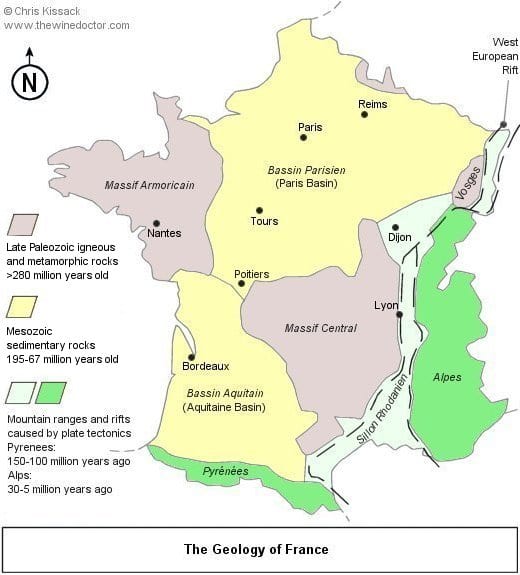Bordeaux Wine Guide: Geology
Before homing in on the wines of Bordeaux, I thought it would be useful to first look at a few geological concepts. Fear not; I have no intention of presenting you with a geological timetable for you to learn. But it makes sense to at least look at the basic rock types, so that we all understand their origins, followed by a very broad overview of the geology of all France. The emphasis here is on the word broad, because in no way will this be a detailed examination. Nevertheless, taking an overview in this fashion not only allows us to understand why Bordeaux’s geology is how it is, it is also useful for understanding other regions of France.
Keeping it simple, then, rock generally has one of these three basic origins:
Igneous: rocks of igneous origin form from magma, either following surface eruptions (producing lava), or from crystallisation of magma within the earth, which solidifies as it rises up to the surface and cools, forming what are known as intrusives beneath the surface of continents or mid-ocean ridges. Examples include granite and gabbro.
Sedimentary: these can be divided into two main groups; silicastics are formed by deposition, often following weathering and erosion of existing rocks in to smaller particles or even individual grains. Examples include sandstone and shale. The carbonates are formed from the precipitation of calcium carbonate, usually as the skeletal material of living organisms. The prime example is limestone. Most sedimentary rocks are deposited in seas or oceans but some can be deposited on land by water (in rivers or lakes) or by wind (desert dunes). Less common groups of sedimentary rocks can be formed by chemical precipitation or evaporation (evaporites, including salt) or result from the preservation of organic-rich plant material (coal).
Metamorphic: these rocks are formed when pre-existing rocks are subjected to extremes of pressure and heat. The original rock may be sedimentary, igneous or metamorphic. For example, limestone subjected to extreme pressure may turn to marble, sandstone may turn to quartzite, shale may turn to slate. With continued heat and pressure these rocks can become further altered through various grades of metamorphism such as schist, gneiss and orthogneiss. In other settings water may be involved, for example when gabbro converts to serpentine.
With these terms under our belt, let’s take a brief overview of France’s geology.
The Geology of France
From this basic understanding of rocks, it is sensible (and indeed correct) to assume that igneous rocks are, in general, older than sedimentary rocks. After all, such rocks were formed on the earth’s surface as it cooled, and persisted for many millions of years before the seas and life forms necessary for the formation of the various sedimentary rocks appeared. Nevertheless, there are of course exceptions to this rule. In the Massif Central, for example, there are volcanic flows from more recent geological eras. Nevertheless, the rule holds true in general; sedimentary rocks are younger than igneous rocks, and for this reason – in France at least – sedimentary rocks tend to lie over more deeply buried igneous rocks.

